Historic Chapels Trust
Foundation and Purpose
The Historic Chapels Trust cares for redundant non-Anglican churches chapels and other places of worship in England. Established in 1993, it takes into ownership buildings of exceptional architectural and historic significance that are no longer used by their congregations. In practice this means buildings listed Grade I or II* by English Heritage. It was founded in response to the large number of places of worship that were being demolished or destroyed by insensitive conversion and it remains the only body with this mission in England.
Once acquired, the buildings are repaired and restored, and then available for new community uses. The places of worship can be of any denomination or faith, other than the Anglican Church. To date they have included Nonconformist chapels and churches, Quaker meeting houses and Roman Catholic churches. The Trust has the power to take synagogues and non-Christian places of worship but in spite of negotiations has not yet done so.[1] The Trust arranges for the chapels to be open to the public at advertised times, and wherever possible it introduces disabled access. Its policy is that the chapels should be used for community activities, including concerts, lectures, conferences, exhibitions, and any other activity compatible with conservation of the building. The Trust also encourages the use of the buildings for services of worship.[2]
Finances
The Trust has no endowment and receives no direct government grant. Its resources are won from English Heritage, the Heritage Lottery Fund, money earned by events at the buildings, grants from trusts and foundations, legacies from Supporters and donations from individuals and Patrons. This is in contrast with the larger Churches Conservation Trust, which received 70 percent of its funding from the Department for Culture, Media and Sport, and the Church of England but which can only take into care Anglican buildings.[2] At about half of its sites the Trust has formed a volunteer local committee to organise events, arrange occasional services of worship. At others it engages volunteers as key-holders and to assist with the maintenance of sites. Whenever possible and appropriate, the Trust installs modern heating and lighting, kitchens and toilets.[2] In 2012 the Trust declared a temporary moratorium on acquiring new sites unless they are donated together with endowment funds, a policy it will review when finances allow.
Activities
The Trust has to date acquired 20 properties.[1] Some have been semi-derelict buildings, such as the Dissenters' Chapel in Kensal Green Cemetery, and Salem Chapel in East Budleigh, Devon. Some chapels are in remote locations, such as Biddlestone Chapel in Northumberland, Farfield Friends Meeting House in West Yorkshire, and Penrose Methodist Chapel in Cornwall. Others are in urban areas, such as Wallasey Memorial Unitarian Church in Merseyside, and St George's German Lutheran Church in London, which houses the Trust's offices. Some of the properties are small and simple, while others are large and elaborate, such as the Bethesda Methodist Chapel in Hanley, Staffordshire, Todmorden Unitarian Church in West Yorkshire, Umberslade Baptist Church in the West Midlands, and the Shrine of Our Lady of Lourdes in Blackpool, Lancashire. During the first 13 years of its existence, the Trust won ten architectural awards, including a Europa Nostra Award for the Dissenters' Chapel.[2]
Governance
The Trust is a secular UK charity. In 2015 the President of the Trust is the Rt Hon Sir Alan Beith, MP, the Chair of Trustees is Debbie Dance OBE and the Director is Roland Jeffery. There is a very small staff and a board of trustees.[3]
Preserved chapels
Key
| Grade | Criteria[4] |
|---|---|
| I | Buildings of exceptional interest, sometimes considered to be internationally important |
| II* | Particularly important buildings of more than special interest |
| II | Buildings of national importance and special interest |
| Name | Location | Photograph | Date[A] | Notes | Grade |
|---|---|---|---|---|---|
| Farfield Friends Meeting House | Addingham, West Yorkshire 53°57′44″N 1°53′08″W / 53.9621°N 1.8855°W |
%2C_Addingham_-_geograph.org.uk_-_675716.jpg) |
1689 | This is a small, simple Quaker meeting house built immediately after the Act of Toleration, on land previously used as a burial ground. Outside the meeting house are five chest tombs of an unusual type for a Quaker burial ground.[5][6] | II* |
| Walpole Old Chapel | Walpole, Suffolk 52°19′24″N 1°28′54″E / 52.3232°N 1.4816°E |
_Congregational_Chapel_-_geograph.org.uk_-_68604.jpg) |
1689 | Built as soon as allowed by the Act of Toleration, the chapel was converted from an existing farmhouse. Initially used by a group of Independent Christians, it later became a Congregational chapel. In the 1860s, it was taken over by the Primitive Methodists.[7][8][9] | II* |
| Cote Baptist Chapel | Bampton, Oxfordshire 51°43′32″N 1°29′35″W / 51.7255°N 1.4930°W |
 |
1703–04 | The chapel was built for a group of Baptists originating on the other side of the River Thames. It was enlarged in the 1750s, and in the late 1850s underwent an extensive restoration. Following another restoration in the 1990s, it is now used for weddings, concerts, and other events.[10][11] | II* |
| Salem Chapel | East Budleigh, Devon 50°39′28″N 3°19′00″W / 50.6577°N 3.3167°W |
 |
1719 | Initially a Presbyterian chapel, it was later used by Congregationalists, and then by the Assemblies of God. Adjacent to it is a separate assembly room. It is now used for concerts and other events, weddings, and the occasional church service.[12][13] | II* |
| Coanwood Friends Meeting House | Haltwhistle, Northumberland 54°55′27″N 2°27′15″W / 54.9243°N 2.4541°W |
 |
1720 | This meeting house stands in an isolated position and is unchanged since it was built, other than the replacement of its thatched roof with slates. The interior retains its original layout, with rows of benches for the congregation and elders still in place. In the burial ground are typical Quaker gravestones, some of which commemorate the Wigham family, who helped to found the meeting house.[14][15] | II* |
| Grittleton Strict Baptist Chapel | Grittleton, Wiltshire 51°31′09″N 2°12′02″W / 51.5193°N 2.2006°W |
— |
c. 1720 | The chapel opened in 1721. It has a rectangular plan with a tiled roof. Inside there are galleries at each end. Under the north gallery is a vestry, in front of which is a pulpit with a staircase and preacher's seat. In the body of the chapel are box pews and a child's pew.[16][17] | II* |
| St George's German Lutheran Church | Alie Street, London 51°30′51″N 0°04′14″W / 51.5142°N 0.0705°W |
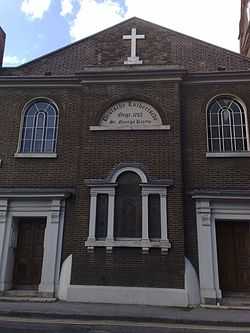 |
1762–63 | St George's was the fifth Lutheran church to be built in London, and continued to be used by Lutherans until 1996. It now contains the offices of the Historic Chapels Trust and is also used for concerts, organ recitals, and other events.[18][19][20] | II* |
| St Benet's Chapel | Netherton, Merseyside 53°29′41″N 2°58′04″W / 53.4946°N 2.9678°W |
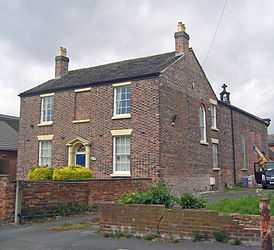 |
1793 | Although it was built after the Catholic Relief Acts that allowed Roman Catholics to worship openly, the chapel is concealed behind the presbytery that appears from the road to be a "standard two-bay house". It retains some of its original fittings, and as of 2010 it is being restored as it would have been before the Second Vatican Council. The presbytery is used as a residence for retired priests.[21][22][23] | II* |
| Bethesda Methodist Chapel | Hanley, Stoke-on-Trent, Staffordshire 53°01′24″N 2°10′37″W / 53.0233°N 2.1769°W |
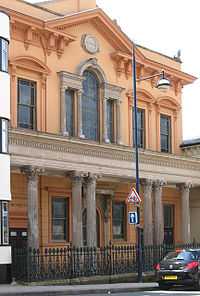 |
1819 | Once known as the "Cathedral of the Potteries", it was built for the Methodist New Connexion. An elaborate portico was added to its frontage in 1859. During the 20th century its congregation declined and its fabric deteriorated, leading to its closure in 1985. Repairs costing £2.5 million are under way as of 2010.[24][25][26] | II* |
| Biddlestone Chapel | Biddlestone, Northumberland 55°22′08″N 2°04′19″W / 55.3688°N 2.0720°W |
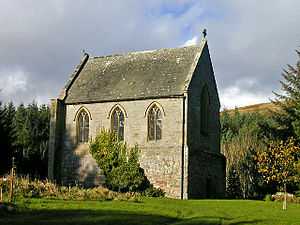 |
c. 1820 | The chapel stands in a remote location and was built as a private chapel for Biddlestone Hall by the Roman Catholic Selby family. The hall has been demolished, but the chapel has been retained. It was built on the remains of a medieval pele tower, incorporating some of its fabric.[27][28] | II* |
| Dissenters' Chapel | Kensal Green Cemetery, London 51°31′37″N 0°12′57″W / 51.5269°N 0.2159°W |
 |
1832 | The first purpose-built Nonconformist chapel to be built in a public cemetery, its condition had deteriorated so much that its wings were demolished in the 1970s. Later that decade, the chapel underwent a major restoration, including rebuilding the wings, and restoring the original painting scheme.[29][30] | II* |
| Thorndon Park Chapel | Thorndon Park, Essex 51°35′55″N 0°19′48″E / 51.5987°N 0.3301°E |
 |
c. 1850 | This was built as the private Roman Catholic chantry chapel and mausoleum for the Petre family in the grounds of Thorndon Hall. It was designed by William Wardell, and is in Decorated style. The interior has an elaborately decorated roof, including depictions of angels, and a richly carved reredos.[31][32] | II* |
| Wainsgate Baptist Church | Hebden Bridge, West Yorkshire 53°45′20″N 2°00′15″W / 53.7555°N 2.0041°W |
 |
1859–60 | The chapel stands in an elevated position overlooking Hebden Bridge. Attached to the rear of the chapel is the former manse, converted into a school in 1890. The chapel closed in 2001, and is now a venue for concerts and other events.[33][34][35] | II* |
| Todmorden Unitarian Church | Todmorden, West Yorkshire 53°42′40″N 2°05′56″W / 53.7111°N 2.0990°W |
 |
1865–69 | The church was built by the Fielden family, local mill owners, and it is constructed using the best quality materials. It was designed by John Gibson in Gothic style with a large spire 196 feet (60 m) high. Following a £1 million programme of repairs, which included restoration of the surrounding landscape and burial ground, it is now used for occasional services, weddings and other events.[36][37][38] | I |
| Westgate Methodist Chapel | Bishop Auckland, County Durham 54°44′14″N 2°08′54″W / 54.7372°N 2.1482°W |
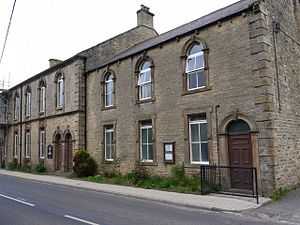 |
1871 | Built for the Primitive Methodists, the chapel closed in 2007. It retains its Victorian layout, complete with the original pews, gallery, windows, a "magnificent organ", and much detailed decoration.[39][40] | II* |
| Umberslade Baptist Church | Hockley Heath, West Midlands 52°20′48″N 1°47′09″W / 52.3467°N 1.7859°W |
 |
1877 | George Ingall designed the church for the Baptist George Frederick Muntz, junior, of Umberslade Hall. It is constructed in blue lias stone in Decorated style with a spire, and has much elaborate detail. Repairs costing about £500,000 were completed in 2008.[41][42] | II |
| Penrose Methodist Chapel | St Ervan, Cornwall 50°29′53″N 4°59′50″W / 50.4980°N 4.9971°W |
— |
1861 | The chapel's plan is a simple rectangle with a single storey. Its interior retains its original layout, with box pews, and benches in the area once occupied by the musicians and choir.[43][44] | II* |
| Longworth Roman Catholic Chapel | Bartestree, Herefordshire 52°03′43″N 2°37′51″W / 52.0620°N 2.6308°W |
— |
1869–70 | Originally the medieval chapel to the manor house at Old Longworth, it was used for agricultural purposes after the Reformation. The chapel was restored in 1851, then moved to a site adjacent to convent at Bartestree in 1869–70. It is probable that the move and rebuilding were supervised by E. W. Pugin.[45][46] | II* |
| Wallasey Memorial Unitarian Church | Wallasey, Merseyside 53°25′18″N 3°02′28″W / 53.4216°N 3.0410°W |
— |
1899 | Designed by Edmund Waring and Edmund Rathbone in Arts and Crafts style, the church is constructed in brick with stone dressings. Many of the internal fittings were designed by Art Nouveau craftsmen from the Bromsgrove Guild.[47][48][49] | II* |
| Shrine of Our Lady of Lourdes | Blackpool, Lancashire 53°49′22″N 3°00′59″W / 53.8229°N 3.0165°W |
1955–57 | The shrine was built as a thanksgiving for the relatively small amount of damage sustained by the Roman Catholic Diocese of Lancaster during the Second World War. It was designed by Francis Xavier Verlarde and is constructed in Portland stone with copper cladding to its roof and flèche. As of 2010 the shrine is being converted into a community centre.[50][51][52] | II* | |
See also
- Churches Conservation Trust, the equivalent body for redundant Anglican churches
- Friends of Friendless Churches, a similar body for churches in Wales and for those turned down by the Churches Conservation Trust
Notes
A This is the date of first construction of the existing building.
References
- ↑ 1.0 1.1 Historic Chapels Trust, Historic Chapels Trust, retrieved 18 June 2012
- ↑ 2.0 2.1 2.2 2.3 Memorandum submitted by the Historic Chapels Trust to the Select Committee on Culture, Media and Sport, Parliament of the United Kingdom, 2006, retrieved 13 July 2010
- ↑ Who We Are, Historic Chapels Trust, retrieved 18 June 2012
- ↑ Listed Buildings, Historic England, retrieved 26 March 2015
- ↑ Farfield Friends Meeting House, Historic Chapels Trust, retrieved 27 June 2010
- ↑ Historic England. "Friends' Meeting House, Addingham (1199556)". National Heritage List for England. Retrieved 18 June 2012.
- ↑ Walpole Old Chapel, Historic Chapels Trust, retrieved 27 June 2010
- ↑ Walpole Old Chapel, Walpole Old Chapel, retrieved 27 June 2010
- ↑ Historic England. "Congregational Chapel, Walpole (1030448)". National Heritage List for England. Retrieved 18 June 2012.
- ↑ Cote Baptist Chapel, Historic Chapels Trust, retrieved 27 June 2010
- ↑ Historic England. "Cote Baptist Chapel, Aston, Cote (1284460)". National Heritage List for England. Retrieved 18 June 2012.
- ↑ Salem Chapel, Historic Chapels Trust, retrieved 27 June 2010
- ↑ Historic England. "Salem Church Including Boundary Walls And Assembly Room, East Budleigh (1097511)". National Heritage List for England. Retrieved 18 June 2012.
- ↑ Coanwood Friends Meeting House, Historic Chapels Trust, retrieved 27 June 2010
- ↑ Historic England. "Friends Meeting House At Ny 710589, Coanwood (1042914)". National Heritage List for England. Retrieved 18 June 2012.
- ↑ Grittleton Strict Baptist Chapel, Historic Chapels Trust, retrieved 18 June 2012
- ↑ Historic England. "Grittleton Baptist Chapel (1363850)". National Heritage List for England. Retrieved 18 June 2012.
- ↑ St George's German Lutheran Church, Historic Chapels Trust, retrieved 27 June 2010
- ↑ St George's German Lutheran Church, St George's German Lutheran Church, retrieved 27 June 2010
- ↑ Historic England. "St George's Lutheran Church and Vestry (1065325)". National Heritage List for England. Retrieved 18 June 2012.
- ↑ St Benet's RC Chapel, Merseyside, Historic Chapels Trust, retrieved 27 June 2010
- ↑ Pollard, Richard; Pevsner, Nikolaus (2006), The Buildings of England: Lancashire: Liverpool and the South-West, New Haven and London: Yale University Press, pp. 521–522, ISBN 0-300-10910-5
- ↑ Historic England. "Church of St Benet and Chapel House (1075849)". National Heritage List for England. Retrieved 18 June 2012.
- ↑ Bethesda Methodist Chapel, Historic Chapels Trust, retrieved 27 June 2010
- ↑ Bethesda Methodist Chapel, Friends of Bethesda, retrieved 27 June 2010
- ↑ Historic England. "Bethesda Methodist Chapel, Stoke-on-Trent (1195821)". National Heritage List for England. Retrieved 18 June 2012.
- ↑ Biddlestone RC Chapel, Historic Chapels Trust, retrieved 27 June 2010
- ↑ Historic England. "Roman Catholic Chapel, Biddlestone (1041304)". National Heritage List for England. Retrieved 18 June 2012.
- ↑ The Dissenters' Chapel, Kensal Green Cemetery, Historic Chapels Trust, retrieved 27 June 2010
- ↑ Historic England. "The Dissenters Chapel, Kensington (1080628)". National Heritage List for England. Retrieved 18 June 2012.
- ↑ Chantry Chapel and Burial Ground, Thorndon Par, Historic Chapels Trust, retrieved 18 June 2012
- ↑ Historic England. "Chantry Chapel and Mausoleum, Thorndon Park (1293260)". National Heritage List for England. Retrieved 18 June 2012.
- ↑ Wainsgate Baptist Church, Historic Chapels Trust, retrieved 27 June 2010
- ↑ Wainsgate Chapel, Wainsgate Chapel, retrieved 28 June 2010
- ↑ Historic England. "Wainsgate Baptist Church And Attached Sunday School (1227399)". National Heritage List for England. Retrieved 18 June 2012.
- ↑ Todmorden Unitarian Church, Historic Chapels Trust, retrieved 27 June 2010
- ↑ Todmorden Unitarian Church, Todmorden Unitarian Church, retrieved 28 June 2010
- ↑ Historic England. "The Unitarian Church, Todmorden (1228988)". National Heritage List for England. Retrieved 18 June 2012.
- ↑ Westgate Methodist Chapel (formerly Primitive Methodist), Historic Chapels Trust, retrieved 27 June 2010
- ↑ Historic England. "Westgate Primitive Methodist Chapel, Stanhope (1232510)". National Heritage List for England. Retrieved 18 June 2012.
- ↑ Christ Church Baptist Church, Tamworth-in-Arden, Historic Chapels Trust, retrieved 27 June 2010
- ↑ Historic England. "Westgate Primitive Methodist Chapel, Stanhope (1382428)". National Heritage List for England. Retrieved 18 June 2012.
- ↑ Penrose Methodist Chapel, Historic Chapels Trust, retrieved 27 June 2010
- ↑ Historic England. "Methodist Chapel, St Ervan (1212478)". National Heritage List for England. Retrieved 18 June 2012.
- ↑ Longworth RC Chapel, Historic Chapels Trust, retrieved 27 June 2010
- ↑ Historic England. "Roman Catholic Church of St James, Bartestree (1099878)". National Heritage List for England. Retrieved 18 June 2012.
- ↑ Wallasey Memorial Unitarian Church, Historic Chapels Trust, retrieved 27 June 2010
- ↑ Pevsner, Nikolaus; Hubbard, Edward (2003) [1971], The Buildings of England: Cheshire, New Haven and London: Yale University Press, p. 371, ISBN 0-300-09588-0
- ↑ Historic England. "Memorial Chapel, Wallasey (1273517)". National Heritage List for England. Retrieved 18 June 2012.
- ↑ Shrine of Our Lady of Lourdes, Historic Chapels Trust, retrieved 27 June 2010
- ↑ Hartwell, Clare; Pevsner, Nikolaus (2009) [1969], The Buildings of England. Lancashire: North, New Haven and London: Yale University Press, pp. 157–158, ISBN 978-0-300-12667-9
- ↑ Historic England. "Thanksgiving Shrine of Our Lady of Lourdes, Blackpool (1387319)". National Heritage List for England. Retrieved 18 June 2012.
External links
| ||||||||||